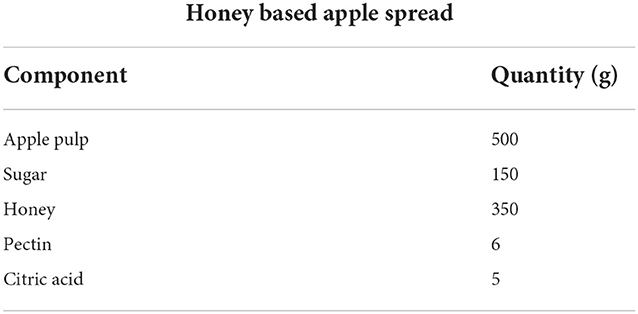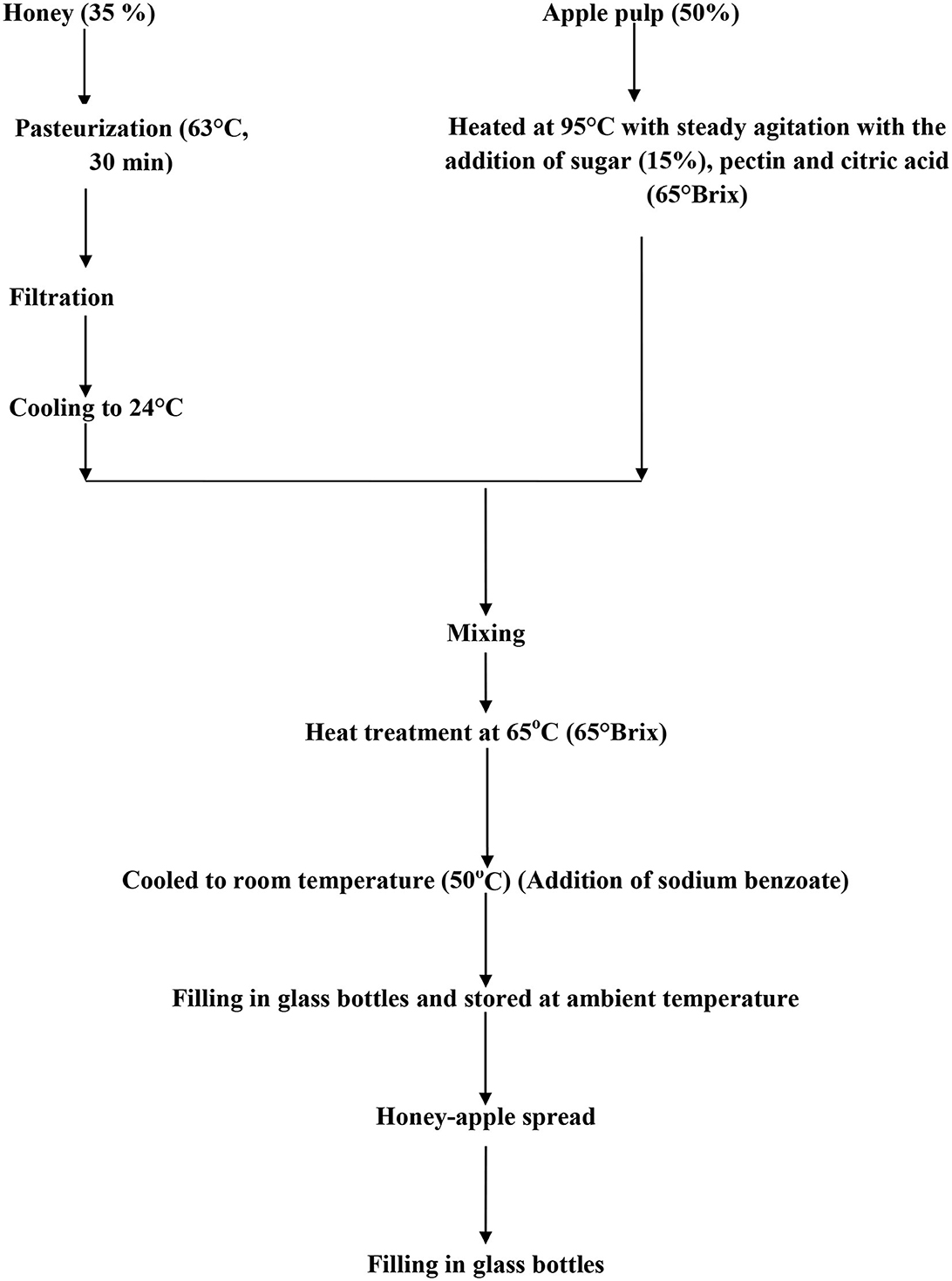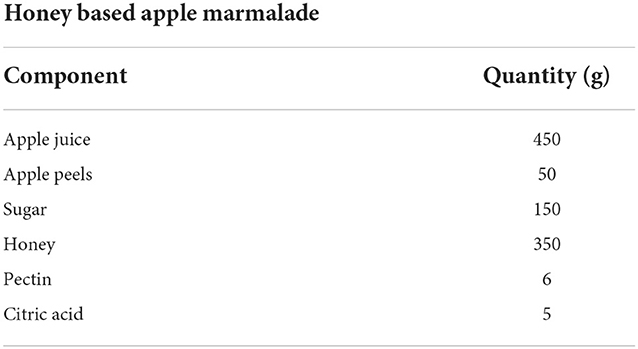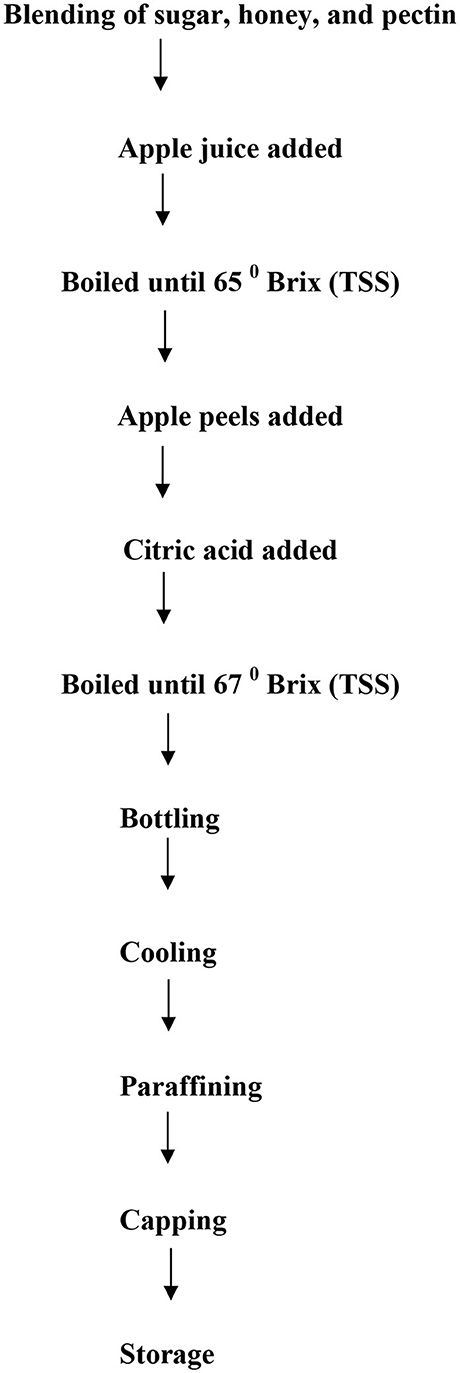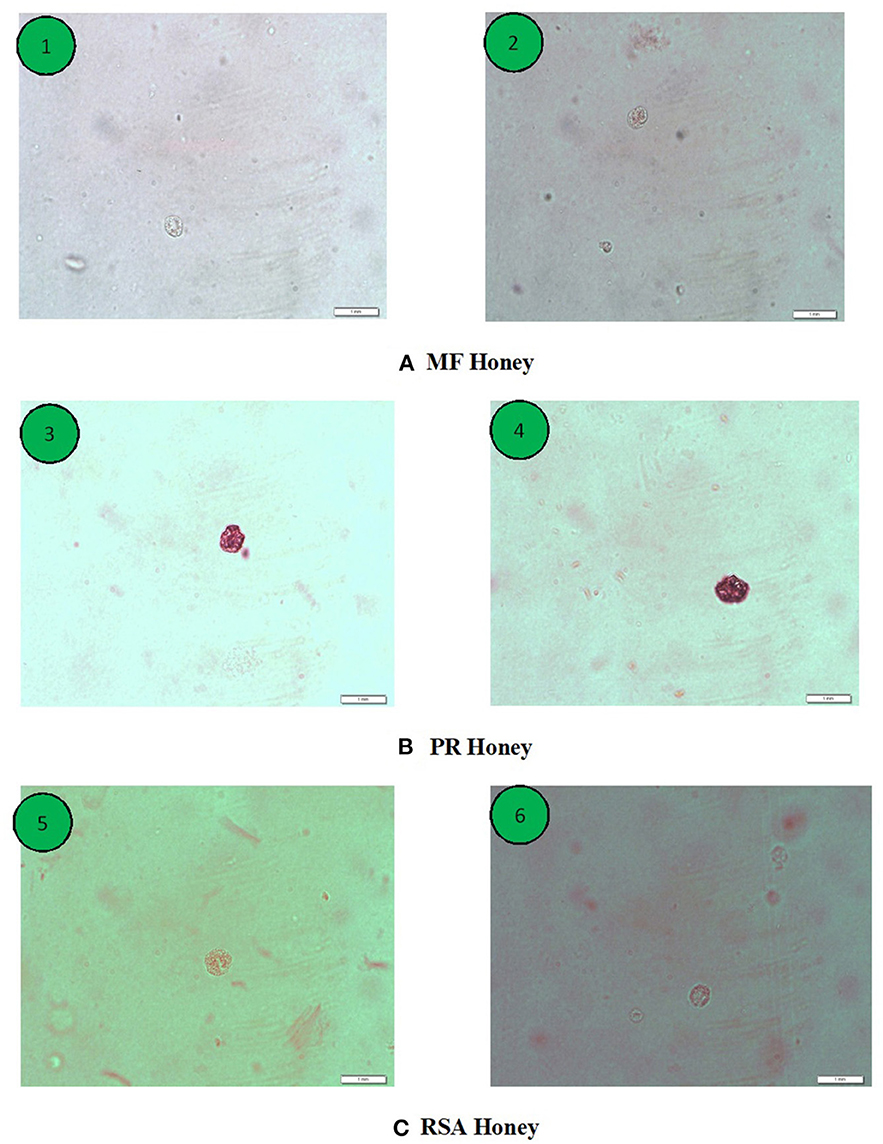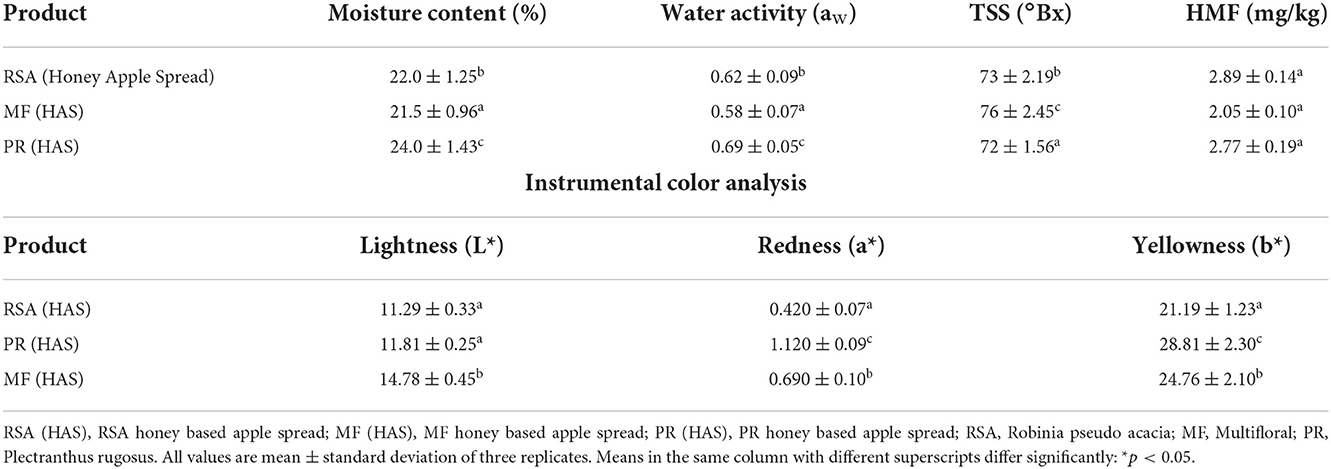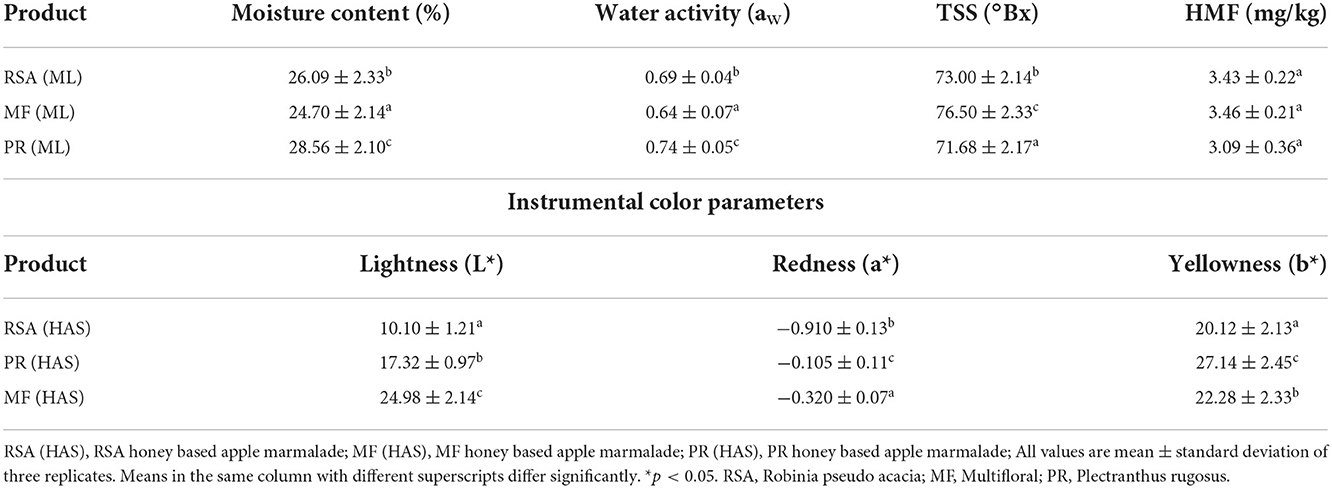- 1Department of Food Technology, Islamic University of Science and Technology, Kashmir, India
- 2Department of Food Science and Technology, University of Kashmir, Jammu & Kashmir, India
- 3Campus Straubing for Biotechnology and Sustainability, Technical University of Munich (TUM), Straubing, Germany
- 4German Institute of Food Technologies (DIL e.V.), Quakenbrück, Germany
- 5Food Microbiology and Biotechnology Laboratory, College of Agriculture and Environmental Sciences, North Carolina A&T State University, Greensboro, NC, United States
This study was carried out to conduct the geographical discrimination of various types of honey, and their utilization in development of novel functional foods where in honey could be substituted in place of white sugar. Honey based apple spread and marmalade products were developed and evaluated for quality analysis. The results showed higher water activity (aw) and moisture content in Plectranthus rugosus (PR) honey based apple spread and marmalade while, TSS was highest (p < 0.05) in Multifloral (MF) honey based apple spread and marmalade. Hydroxymethylfurfural was found to be in the ranged of 6.77–7.05 (mg/kg) for honey based apple spread products and 3.09–3.46 (mg/kg) for honey based apple marmalade products. The lightness (L*) value was significantly highest in MF honey based apple spread and marmalades (p < 0.05). Redness (a*) and yellowness (b*) values were significantly highest in PR honey based apple spreads and marmalades and lowest in Robinia pseudo acacia (RSA) honey based apple spread and marmalades. In general, all MF honey based apple spreads and marmalades has the highest score for overall acceptability in comparison to RSA and PR honey based apple spreads. The values of gel strength (Fe), rupture force (FR), energy of penetration (E) and adhesiveness (A) in the given spread products were in the range of 1.50–1.54 N, 1.70–1.73 N, 17.00–17.05 Ns and −1.11–−1.08 Ns, respectively. The values of gel strength (Fe), rupture force (FR), energy of penetration (E) and adhesiveness (A) in the investigated marmalade products were in the range of 1.65–1.69 N, 2.08–2.13 N, 16.05–16.10 Ns and −1.14–−1.10 Ns, respectively.
Introduction
Honey is a hyper saturated fluid or semi-solid natural product made by bees from blossom nectar (Dashora et al., 2011; Hilary et al., 2017). As per the Codex alimentarius standards (Codex and Intergovernmental, 2001), “Honey is a natural sweet substance produced by honey bees from plant nectar, plant secretions, or plant-sucking insect excretions on living parts of plants, which the bees collect, transform by combining with specific substances of their own, deposit, dehydrate, store, and leave in the honey comb to ripen and mature.” The honey can be classified on the basis of flower and extra flower nectar as honey or dew honey and also on the basis of source as well as the plant. Berseem honey, Litchi honey, Eucalyptus honey, Brassica honey are some of the floral sources of honey.
Honey is a popular natural product that is valued for its flavor, nutritional value as well as for its health benefits. Global sales of honey originating from natural origin in 2019 were estimated at US$ 1.99 billion, with natural honey exports declining by 14.4 percent for all exporting countries since 2015 (Workman, 2021). During the year of 2019-20, India exported 59,536.75 MT of natural honey to the world for a value of Rs. 633.82 Crore/ 88.65 USD Millions. The major honey export destinations for the year 2010-2020 were the USA, Saudi Arabia, UAE, Canada and Qatar (APEDA, 2000).
The state of Jammu and Kashmir is one of the Indian subcontinent's potential beekeeping zones having geographical location of 32°-17' to 37°-05' N and 72°-40' to 80°-30' E. A good area under forests and negligible amount of agro-chemicals used in agriculture in J&K increases the potential of organic honey production (Sharma et al., 2014). A total of 2.27 Thousand Tons of honey was produced in 2018-19, as per the J&K budget through Department of Horticulture.
Honey consists of around 200 compounds, including water, sugars, vitamins, enzymes, amino acids, minerals and bioactive compounds (Rodríguez et al., 2019). Sugars are the main material, comprising ~95–99 percent of the dry matter of honey. Fructose is the most abundant of the sugars, containing ~32–38 percent of sugar. Additionally maltose, sucrose, maltotriosis and pantose are also present (do Nascimento et al., 2018). There are different vitamins in honey, such as vitamins C, thiamine, B5, riboflavin, niacin, B6, B8, B9, and B12. In addition to various enzymes, honey contains lipids, proteins, volatile compounds, phenolic acids, organic acids, flavonoids and carotenoids (Blasa et al., 2007).
The conversion of honey to a solid state has the potential to improve the product's stability. Powder made from honey can also be readily mixed with other materials or applied directly to spices or as dry coatings (Cui et al., 2008). However the preparation of powdered honey is still a major challenge for industries as well as to the researchers. Since honey contains a substantial number of low molecular weight sugars, drying it in its natural state is difficult. It is impossible to prepare the honey powder without the addition of carriers due to its “stickiness behavior,” which is caused by the lower glass transition temperatures of fructose and glucose (Jayasundera et al., 2011). Dried honey powder is obtained from freshly harvested honey to which few processing aids as well as other ingredients are mixed and subsequently dried to lower moisture content. Researchers attempted the development of honey powder utilizing processes such as vacuum drying, spray drying and microwave-vacuum drying, but with mixed results in terms of product quality and ease of use (Wang et al., 2011). Drying and anticaking agents are added with the aim to enhance the drying features and minimize the cake formation in the product. Gums like xanthan and gum arabica are also used to improve the product's powder forming and drying qualities (Adhikari et al., 2009). Another possible way for obtaining honey powder that retains biological components while improving physical characteristics is to use freeze drying technology. Freeze-drying (FD) produces the best quality food product in comparison to the other drying methods (Ratti, 2013). Despite the amorphous powders caking and handling problem, freeze drying offers the advantage of rapid disintegration which can be utilized to bioactive encapsulation due to the porous microstructure (Palzer et al., 2012). Despite above advantages, the application of freeze drying for the production of honey rich powders has rarely been investigated.
In the face of highly global competitive market with more conscious and demanding customers, the diversification of agriculture based food products, is becoming increasingly relevant. In this context, modern high-quality goods are highly significant for industrial and rural sustainability, guaranteeing food safety (Anjos et al., 2020). The principal driver of the present work was the challenge to exploit the high nutritional quality, functional properties and sweetness of honey and to encourage food processors to use it in different type of food products. Honey based products are gaining popularity throughout the world because of their potential health benefits (Mouhoubi-Tafinine et al., 2016). The product development and various aspects of product characteristics are missing in literature and simultaneously there is an increasing demand for diversified honey based products like honey spread, honey-fruit spread and honey-fat spreads with added therapeutic purposes. Till now, little research work has been conducted on honey found in the North Himalayan region of J&K regarding the geographical discrimination of various types of honey and their utilization in development of novel functional products in which honey could replace sugar having enhanced shelf life. The present study was therefore undertaken with the following objectives.
1. Geographical discrimination in north western Himalayas.
2. Development and quality evaluation of honey based spreads and marmalades with better nutraceutical and nutritional properties.
Materials and methods
The present study value addition of honey with enhanced nutraceutical and nutritional potential was carried out in Department of Food Science and Technology, University of Kashmir, Hazratbal, Srinagar (Jammu & Kashmir) during 2017–2021.
Materials
Chemicals and reagents
Gallic acid, HPLC-grade CH3OH, Folin–Ciocalteu (FC) reagent, 1, 1-diphenyl-2-picrylhydrazyl, Aluminum chloride, quercetin and Na2CO3 were ordered from Sigma Aldrich Chemical Co. (MO, USA). Liquefied glycerine jelly (Kaiser's Glycerol Gelatine), Carrez solution I and Carrez solution II were obtained from Hi-Media Pvt. Ltd. FC reagent was bought from Merck. Analytical grade chloroform, methanol, sulphuric acid, hydrochloric acid and ethylacetate were purchased from Qualikems Fine Chemical Pvt. Ltd., India.
Honey sample collection
Sample honey was obtained from the locals honey farmers of J and K. The samples were packed in glass bottles and stored at 4°C prior to analysis and products development. Details of season of harvesting of honey obtained from various floral sources.

Drying aid/carriers
Encapsulating agents such as maltodextrin and whey protein isolate were bought from Mumbai (Hi-Media Pvt. Ltd.) India.
Methods
Melissopalynological characterization
Melissopalynology was used to confirm the origin of each honey sample studied. The samples were grouped as per botanical origin by means of the enumerated way (Von Der Ohe et al., 2004). Honey sample 10 g was dissolved in 20 ml warm distilled water. After this the centrifugation of the solution was carried at 3,000 rpm for 10 min. The supernatant was decanted, then the sediment was again added 10 ml of distilled water, centrifuged for at 3,000 rpm for 5 min. Finally, the sediments were put on a slide, spread out, dried and covered with a liquefied glycerine jelly (Kaiser's Glycerol Gelatine) and covered with cover slip. Nearly 6 hundred pollens were counted using binocular light-microscope (Olympus CX21iLEDFS1) with magnifications 40 × 15.
Calculations of pollen count in honey
Four frequency classes have been suggested (Louveaux et al., 1978) as mentioned below. Classification of pollen frequency.
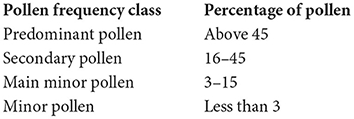
The honey samples were classified as “unifloral”, having a predominant pollen type and samples containing more than one species were classified as “multifloral”.
Development and quality evaluation of honey based apple spread
Preparation of honey based apple spread
Honey spread was prepared by using the standard method of Dyce and Johnston method (Dyce, 1979). The apple pulp (50%)
were cooked to 95°C with steady stirring before being formed with sugar (15%), citric acid and pectin in suitable measures. The combination thus obtained was then cooked until it reached a fairly viscous and concentrated mass of 65°Brix. Honey (35%) was pasteurized at 63°C for 30 min, filtered and cooled to 24°C (Table 1A). The cooled honey was added to the prepared mixture (apple pulp and sugar). The apple pulp-sugar mixture and honey were mixed and heated slightly to achieve 65°Brix honey apple spread. C7H5NaO2 was supplemented following cooling the blend to 50°C. Later on whole blend was packed in pre-sterilized glass bottles and stored at ambient temperature (Figure 1).
Quality evaluation of honey based apple spreads
The honey based apple spreads were evaluated for different parameters like moisture content, aw, TSS, instrumental color, sensory and textural properties using standard methods as described below.
Moisture content
The moisture content was evaluated using Abbe refractometer (Atago, Japan). The resultant moisture content was calculated from the Chataway table corrected for a standard temperature of 20°C by adding the correction factor of 0.00023/°C (AOAC, 2012).
Water activity (aw)
Sample of ~1 g was used for determining water activity (aw) using a dew-point water activity meter (Aqualab Series 4 model TE, Pullman, Washington, USA), at 25°C ± 0.2°C, with a temperature controlled system (Chirife et al., 2006).
Hydroxymethylfurfural
The HMF was evaluated using spectrophotometer method. A clarified solution of 5 g of spread in a 50 ml volumetric flask was prepared using 0.5 ml of Carrez I [15% w/v, K4Fe(CN)6.3H2O] and 0.5 ml of Carrez II [30% w/v, Zn(CH3COO)2.2H2O] reagents. Absorbance was determined at 284 as well as 336 nm in a UV-Visible Spectrophotometer (HITACHI-330, Germany). The results were calculated using Equation (1) and expressed as mg/Kg (Codex and Intergovernmental, 2001).
Where,
A284 = absorbance at 284 nm;
A336 = absorbance at 336 nm;
149.7 = constant;
5 = nominal sample weight;
D = Dilution factor if required; and
M = mass (g) of spread sample.
Instrumental color
Color characteristics were assessed by the CIE L*a*b* method. The CIE lightness (L*), redness (a*) and yellowness (b*) values of honey based apple spread samples was evaluated using a Hunter Color Lab (Mini Scan XE Plus, 45/0-L, Reston, USA)according to the standard method described by Saxena et al. (2010).
Sensory analysis
Sensory analysis of honey-based apple spread products were evaluated by 35-member trained sensory panel comprising of researchers as well as faculty members. Sensory profiling was carried out employing a modified version of Piana et al. (2004), general descriptive analysis approach. The product was evaluated for appearance, aroma, density, texture and overall acceptability using a 9-point hedonic scale with 1 representing extreme dislike and 9 extreme like. Drinking water was provided for palate cleansing between each sample. These experiments were conducted according to established ethical guidelines, and informed consent obtained from the participants. This study complies with all regulations and confirmation that informed consent was obtained.
Texture analysis
The texture analysis of honey-based apple spread products were done, following the standard procedure using texture analyzer (TA.HD. Plus, Stable Micro Systems, Godalming, Surrey, UK). The texture of the products was specified using below mentioned indicators:
i) Gel strength (Fe [N]), ii) Rupture force (FR [N]), iii) Energy of penetration (E [Ns]), iv) Adhesiveness (A [Ns]).
First 3 parameters indicates gel hardness, last one indicates tendency to stick to surfaces.
Development and quality evaluation of honey based apple marmalade
Preparation of honey apple marmalade
Preparation of honey based apple marmalade was performed by the procedure as follow. All the necessary materials were correctly measured (Table 1B). Sugar/honey and pectin were thoroughly blended. Then apple juice was supplemented to the blend. The mixture was heated till 65° brix (TSS). Citric acid and apple peel was supplemented. The blend was then heated up to 67° brix (TSS). Sodium benzoate was added subsequently and the marmalade made was immediately transferred into previously sterilized glass bottles. The marmalade thus prepared was properly cooled to room temperature (Figure 2).
Quality evaluation of honey based apple marmalades
The honey based apple marmalade developed were evaluated for different parameters like moisture content, water activity, total soluble solids, instrumental color, sensory and textural properties using standard methods as described below.
Results and discussion
Melissopalynological characterization of honey produced in north western Himalayas
Melissopalynology or Pollen analysis of the honey is of great importance for tracing the source of honey. Pollen identification revealed that in apiaries of North Western Himalaya, 77 different forage species (pollen and nectar producing plants) pertaining to 56 genera and 38 families were used for production of honey (Figure 3). The major aquatic sources of the pollen identified were Nelumbo nucifera, Nymphae alba. L, Polygonum hydropiper and Nymphoides peltata. Nelumbo nucifera belongs to family Nelumbonace commonly known as Lotus and wild in nature found in abundance in the various water bodies of valley. Nymphae alba belongs to family Nymphaeaceae commonly known as water lily and wild in nature. Polygonum hydropiper belongs to family Polygonaceae, commonly known as Water smartweed and wild in nature. Nymphoides peltata Kuntze belongs to family Menyanthaceae commonly known as fringed water lily also wild in nature.
Development and quality evaluation of honey based fruit products
Evaluation of honey based apple spread
Physico-chemical characteristics of honey based apple spread
The physico-chemical characteristics of honey based apple spread products are presented in Table 2. The moisture, water activity (aw) and Total Soluble Solids (TSS) contents ranged from 21.5–24%, 0.596–0.69 and 72–76 °CBx respectively. The findings revealed higher water activity (aw) and moisture content was recorded in PR honey based apple spread while, TSS was highest in MF honey based apple spread (p < 0.05). The higher moisture content and water activity (aw) of PR honey based apple spread could be because of its variation in chemical composition of honey varieties particularly sugar profile as same content and type of fruit was used in all spread formulations (Abramovič et al., 2008; Saxena et al., 2010). Eke-Ejiofor and Owuno (2013) stated that moisture content as well as water activity (aw) has an influence on the shelf life of foodstuff. Ashaye and Adeleke (2009) also stated that the moisture content as well as water activity (aw) of any food material is a measure of its shelf life. The higher TSS of MF honey based apple spread might be due to the highest TSS content of MF honey which resulted its variation in the final product (Küçük et al., 2007). Hydroxymethylfurfural content of honey based apple spreads was found to be in the ranged of 2.05–2.89 (mg/kg) and exhibited non-significant variation among honey based apple spread products (p > 0.05). The results were in agreement with the findings of earlier researchers (Lakhanpal and Vaidya, 2015) who found similar results in honey basedfruit products.
Instrumental color
Color of food products is one of the important characteristic professed by the customers, which plays a critical role about the consumer behavior vis a vis the given food product. The color of honey based fruit products is related to the mineral content, pollen profile, phenolics of fruit and honey and is also characteristic of honey source (Lazaridou et al., 2004; González-Miret et al., 2005; Baltrušaityte et al., 2007; Bertoncelj et al., 2007). The CIE lightness (L*), redness (a*) and yellowness (b*) chromatic coordinates of honey-based apple spread products is shown in Table 2. The results exhibited that lightness (L*) value was significantly highest in MF honey based apple spread (p < 0.05) while, there was no substantial difference between RSA and PR honey based apple spread products (p > 0.05). The a* and b* values were significantly highest in PR honey based apple spreads and lowest in RSA honey based apple spread (p < 0.05). Thus, the results showed that the analyzed PR honey-based apple spread product had more red and yellow components and could be attributed to the high intensity of red and yellow components in PR honey as same concentration of fruit was used in formulation of all spread products (Machado De-Melo et al., 2018).
Sensory analysis
Sensory analysis is the useful tool in product characterization which involves the evaluation characteristic attributes of the food products by the human senses. Honey-based apple spread products were evaluated by 35-member trained panel for sensory evaluation comprising faculty members and researchers, whose ages ranged between 24–35 years and were asked to report their opinion of the product. The product was evaluated for appearance, aroma, density, texture as well as overall acceptability. The results of honey based apple spread products were presented in Table 3. The MF honey based apple spread has the highest score for appearance in comparison to RSA and PR honey based apple spreads thus, exhibited highest overall acceptability (p < 0.05). However RSA and PR honey based apple spreads exhibited non-significant difference in overall acceptability (p > 0.05). Earlier researchers reported that honey based fruit products posses the sensory characteristics typical of the honey type which depends on flora of the habitat where it was produced as well as its influenced by geographical origin (González-Viñas et al., 2003). Overall all honey-based apple spread products displayed fine sensory quality suggesting that addition of apple did not have any adverse effect on the sensory properties of honey based apple spreads. This is important while understanding the product characteristics and their impact on consumer acceptability. Some researchers have suggested that it is appropriate to add dried fruits instead of pulp while preparing fruit based spread from honey (Hebbar et al., 2008) because of rheological behavior of honey, researchers are focusing their efforts to modify physical properties of honey with an objective to ease its handling.
Texture analysis
In the preparation of honey based apple spreads addition of honey is the prime factor which determines the consistency of final product. So to measure spread texture, the values of rupture force (FR), gel strength (Fe) and energy of penetration (E) referring to gel hardness, were determined, together with adhesiveness (A) (Table 4). The values of Fe, FR, E and A in the explored spread products were within the range of 1.50–1.54 N, 1.70–1.73 N, 17.00–17.05 Ns, and −1.11–−1.08 Ns, respectively. The texture parameters studied exhibited non-significant variation in all honey based apple spread products (p > 0.05). Thus, the results exhibited that different honey types used in formulation of spread products had no affect on the texture parameters. The results are consistent with the findings of Raj et al. (2017) who studied similar texture parameters in papaya jam incorporated with whey.
Evaluation of honey based apple marmalade
Physico-chemical characteristics of honey based apple marmalade
The physico-chemical characteristics of honey based apple marmalade products are presented in Table 5. The moisture, water activity (aw) and TSS contents ranged from 24.70–28.56%, 0.64–0.74, and 71.68–76.50 °CBx, respectively. Significantly higher moisture content as well as water activity (aw) was observed in PR honey based apple marmalade however TSS was highest in MF honey based apple marmalade (p < 0.05). Since same content and type of fruit was used in all marmalade formulations, higher moisture and water activity (aw) of PR honey based apple marmalade products could be because of variation in chemical composition in the types of honey particularly sugar profile (Abramovič et al., 2008; Saxena et al., 2010). The higher TSS of MF honey based apple marmalade might be due to the highest TSS content of MF honey which resulted in difference in the final product (Küçük et al., 2007). Almost identical resultswere reported by earlier researchers in honey based fruit products (Lakhanpal and Vaidya, 2015). Hydroxymethylfurfural (HMF) content of honey based apple marmalade products ranged from 3.09–3.46(mg/kg). The hydroxymethylfurfural content exhibited non-significant variation among honey based apple marmalade products (p > 0.05). HMF is an indicator of processing treatment and storage of high sugar products.
Instrumental color
CIE lightness (L*), redness (a*) and yellowness (b*) color parameters of honey-based apple marmalade products is shown in Table 5. The results exhibited that lightness (L*) value was significantly highest in MF honey based apple marmalade followed by PR and RSA honey based apple marmalade products (p < 0.05). The greeness (a*) and yellowness (b*) values were significantly highest in PR honey based apple marmalades and lowest in RSA honey based marmalade (p < 0.05). Since honey and fruit contents were constant in all formulations. Thus, the results highlight that the analyzed PR honey-based apple marmalade product had more red as well as yellow components and could be attributed to the high intensity of yellow and red constituents in PR honey (Machado De-Melo et al., 2018). The findings are in agreement with the findings of earlier researchers (Vulić et al., 2014).
Sensory analysis
The sensorial characteristics of honey-apple based marmalade products were evaluated by a 35-member trained panel for sensory evaluation consisting of faculty members and researchers, whose ages ranged between 24 to 35 years and were asked to report their opinion of the product. The product was evaluated for appearance, aroma, density, texture as well as overall acceptability. The results of honey based apple marmalade products were presented in Table 4. Here the quantity of fruit and honey is constant in all products however, varying on the basis of honey type. The trained panelists do not distinguish any difference in aroma, density and texture scores; however the appearance score was significantly highest in MF type honey based marmalade and lowest in RSA type honey based marmalade (p < 0.05). This variation in appearance might be due to the color difference in honey types used in formulation of the products. Earlier researchers also reported that appearance of honey based products varied with characteristic fruit and honey type used in the preparation of the product. Overall, all honey-based apple marmalade formulation from MF honey type exhibited significantly higher and RSA honey type marmalade exhibited lowest overall acceptability (p < 0.05). The variation could be attributed to the difference in appearance scores of the products. The recorded sensory scores is an indication that all honey based apple marmalade products were highly acceptable by the consumers. Further, overall acceptability of all products is beyond 7 on a 9-point hedonic scales revealed that they were highly acceptable by the panelists.
Texture analysis
Various parameters are including rupture force (FR), gel strength (Fe), energy of penetration (E) referring to gel hardness, as well as adhesiveness (A) of honey based apple marmalade products (Table 3) were assessed using texture analyser. The values of gel strength (Fe), rupture force (FR), energy of penetration (E) and adhesiveness (A) in the investigated marmalade products were in the range of 1.65–1.69 N, 2.08–2.13 N, 16.05–16.10 Ns, and −1.14–−1.10 Ns, respectively. The textural parameters exhibited non-significant variation in all marmalade products (p > 0.05). Thus, marmalade products from apple and different honey types were found to possess similar textural properties. Similar results for all these textural parameters were reported by Garg et al. (2019) who studied jamun and apple marmalade products.
Conclusion
This study was carried out to conduct the geographical discrimination of various types of honey found in the North Himalayan region of J&K, and their utilization in development of novel functional foods where in honey could be substituted in place of white sugar. Honey is a super saturated solution or semi-solid natural product synthesized from nectar of flower by honey bees. It is possible that studies can be effective in tracing the geographical and floral origin and to evaluate the honeys from Kashmir Himalayas on the basis of physicochemical, antioxidant and spectroscopic characteristics. Honey based apple spread and marmalade products were developed and evaluated for quality analysis. The products were highly acceptable by the consumers as indicated by sensory evaluation. All multifloral based honey apple marmalades exhibited significant higher and robinia pseudo acacia based honey type marmalade exhibited lowest overall acceptability. Further, overall acceptability of all products was beyond 7 on a 9-point hedonic scale revealed their acceptability by the panelists.
Data availability statement
The original contributions presented in the study are included in the article/supplementary material, further inquiries can be directed to the corresponding author.
Ethics statement
Ethical review and approval was not required for the study on human participants in accordance with the local legislation and institutional requirements. Written informed consent from the participants was not required to participate in this study in accordance with the national legislation and the institutional requirements.
Author contributions
All authors listed have made a substantial, direct, and intellectual contribution to the work and approved it for publication.
Conflict of interest
The authors declare that the research was conducted in the absence of any commercial or financial relationships that could be construed as a potential conflict of interest.
Publisher's note
All claims expressed in this article are solely those of the authors and do not necessarily represent those of their affiliated organizations, or those of the publisher, the editors and the reviewers. Any product that may be evaluated in this article, or claim that may be made by its manufacturer, is not guaranteed or endorsed by the publisher.
References
Abramovič, H., Jamnik, M., Burkan, L., and Kač, M. (2008). Water activity and water content in Slovenian honeys. Food Control 19, 1086–1090. doi: 10.1016/j.foodcont.2007.11.008
Adhikari, B., Howes, T., Wood, B. J., and Bhandari, B. R. (2009). The effect of low molecular weight surfactants and proteins on surface stickiness of sucrose during powder formation through spray drying. J. Food Eng. 94, 135–143. doi: 10.1016/j.jfoodeng.2009.01.022
Anjos, O., Canas, S., Gonçalves, J. C., and Caldeira, I. (2020). Development of a spirit drink produced with strawberry tree (Arbutus unedo L.) fruit and honey. Beverages 6, 38. doi: 10.3390/beverages6020038
AOAC (2012). Association of Official Analytical Chemists International – AOAC Official Methods of Analysis of AOAC International. Gaithersburg, Maryland, USA.
APEDA (2000). The Agricultural and Processed Food Products Export Development Authority (APEDA), Government of India. Available online at: http://www.apeda.gov.in (accessed August 3, 2020).
Ashaye, O. A., and Adeleke, T. O. (2009). Quality attributes of stored Roselle jam. Int. Food Res. J. 16, 363–371.
Baltrušaityte, V., Venskutonis, P. R., and Ceksteryte, V. (2007). Radical scavenging activity of different floral origin honey and beebread phenolic extracts. Food Chem. 101, 502–514. doi: 10.1016/j.foodchem.2006.02.007
Bertoncelj, J., Doberšek, U., Jamnik, M., and Golob, T. (2007). Evaluation of the phenolic content, antioxidant activity and colour of Slovenian honey. Food Chem. 105, 822–828. doi: 10.1016/j.foodchem.2007.01.060
Blasa, M., Candiracci, M., Accorsi, A., Piacentini, M. P., and Piatti, E. (2007). Honey flavonoids as protection agents against oxidative damage to human red blood cells. Food Chem. 104, 1635–1640. doi: 10.1016/j.foodchem.2007.03.014
Chirife, J., Zamora, M. C., and Motto, A. (2006). The correlation between water activity and% moisture in honey: Fundamental aspects and application to Argentine honeys. J. Food Eng. 72, 287–292. doi: 10.1016/j.jfoodeng.2004.12.009
Codex, A., and Intergovernmental, T. F. O. (2001). Joint FAO/WHO Food Standard Programme Codex Alimentarius Commission Twenty-Fourth Session Geneva, 2-7 July 2001. Codex.
Cui, Z. W., Sun, L. J., Chen, W., and Sun, D. W. (2008). Preparation of dry honey by microwave–vacuum drying. J. Food Eng. 84, 582–590. doi: 10.1016/j.jfoodeng.2007.06.027
Dashora, N., Sodde, V., Bhagat, J. S., Prabhu, K., and Lobo, R. (2011). Antitumor activity of Dendrophthoe falcata against ehrlich ascites carcinoma in swiss albino mice. Pharmaceutical Crops 2, 1–7. doi: 10.2174/2210290601102010001
do Nascimento, K. S., Sattler, J. A. G., Macedo, L. F. L., González, C. V. S., de Melo, I. L. P., da Silva Araújo, E., et al. (2018). Phenolic compounds, antioxidant capacity and physicochemical properties of Brazilian Apis mellifera honeys. LWT 91, 85–94. doi: 10.1016/j.lwt.2018.01.016
Dyce, E. J. (1979). “Producing finely granulated or creamed honey,” in Honey — A Comprehensive Survey, ed E. Crane (London: Heinemann), 293–306.
Eke-Ejiofor, J., and Owuno, F. (2013). The physicochemical and sensory properties of jackfruit (Artocarpus heterophilus) jam. Int. J. Nutr. Food Sci. 2, 149–152. doi: 10.11648/j.ijnfs.20130203.19
Garg, S., Ghosh, P., Rana, S. S., and Pradhan, R. C. (2019). Preparation and quality evaluation of nutritionally enriched jam made from blends of indian blackberry and other fruits. Int. J. Fruit Sci. 19, 29–44. doi: 10.1080/15538362.2018.1536872
González-Miret, M. L., Terrab, A., Hernanz, D., Fernández-Recamales, M. Á., and Heredia, F. J. (2005). Multivariate correlation between color and mineral composition of honeys and by their botanical origin. J. Agric. Food Chem. 53, 2574–2580. doi: 10.1021/jf048207p
González-Viñas, M. A., Moya, A., and Cabezudo, M. D. (2003). Description of the sensory characteristics of Spanish unifloral honeys by free choice profiling. J. Sensory Stud. 18, 103–113. doi: 10.1111/j.1745-459X.2003.tb00378.x
Hebbar, U. H., Rastogi, N. K., and Subramanian, R. (2008). Properties of dried and intermediate moisture honey products: a review. Int. J. Food Propert. 11, 804–819. doi: 10.1080/10942910701624736
Hilary, S., Habib, H., Souka, U., Ibrahim, W., and Platat, C. (2017). Bioactivity of arid region honey: an in vitro study. BMC Complement. Alter. Med. 17, 1–10. doi: 10.1186/s12906-017-1664-9
Jayasundera, M., Adhikari, B., Adhikari, R., and Aldred, P. (2011). The effects of proteins and low molecular weight surfactants on spray drying of model sugar-rich foods: powder production and characterisation. J. Food Eng. 104, 259–271. doi: 10.1016/j.jfoodeng.2010.12.017
Küçük, M., Kolayli, S., Karaoglu, S., Ulusoy, E., Baltaci, C., and Candan, F. (2007). Biological activities and chemical composition of three honeys of different types from Anatolia. Food Chem. 100, 526–534. doi: 10.1016/j.foodchem.2005.10.010
Lakhanpal, P., and Vaidya, D. (2015). Development and evaluation of honey based mango nectar. J. Food Sci. Technol. 52, 1730–1735. doi: 10.1007/s13197-013-1122-8
Lazaridou, A., Biliaderis, C. G., Bacandritsos, N., and Sabatini, A. G. (2004). Composition, thermal and rheological behaviour of selected Greek honeys. J. Food Eng. 64, 9–21. doi: 10.1016/j.jfoodeng.2003.09.007
Louveaux, J., Maurizio, A., and Vorwohl, G. (1978). Methods of melissopalynology. Bee World 59, 139–157. doi: 10.1080/0005772X.1978.11097714
Machado De-Melo, A. A., Almeida-Muradian, L. B. D., Sancho, M. T., and Pascual-Maté, A. (2018). Composition and properties of Apis mellifera honey: a review. J. Apicult. Res. 57, 5–37. doi: 10.1080/00218839.2017.1338444
Mouhoubi-Tafinine, Z., Ouchemoukh, S., and Tamendjari, A. (2016). Antioxydant activity of some algerian honey and propolis. Industr. Crops Produc. 88, 85–90. doi: 10.1016/j.indcrop.2016.02.033
Palzer, S., Dubois, C., and Gianfrancesco, A. (2012). Generation of product structures during drying of food products. Drying Technol. 30, 97–105. doi: 10.1080/07373937.2011.622060
Piana, M. L., Oddo, L. P., Bentabol, A., Bruneau, E., Bogdanov, S., and Declerck, C. G. (2004). Sensory analysis applied to honey: state of the art. Apidologie 35, S26. doi: 10.1051/apido:2004048
Raj, P. A. A., Radha, K., Vijayalakshmi, M., Pavulraj, S., and Anuradha, P. (2017). Study on the utilization of paneer whey as functional ingredient for papaya jam. Italian J. Food Sci. 29, 171.
Ratti, C. (2013). “Freeze drying for food powder production,” in Handbook of Food Powders (Woodhead Publishing), 57–84. doi: 10.1533/9780857098672.1.57
Rodríguez, I., Cámara-Martos, F., Flores, J. M., and Serrano, S. (2019). Spanish avocado (Persea americana Mill.) honey: authentication based on its composition criteria, mineral content and sensory attributes. LWT 111, 561–572. doi: 10.1016/j.lwt.2019.05.068
Saxena, S., Gautam, S., and Sharma, A. (2010). Physical, biochemical and antioxidant properties of some Indian honeys. Food Chem. 118, 391–397. doi: 10.1016/j.foodchem.2009.05.001
Sharma, D., Abrol, D. P., Ahmad, H., Bandral, R. S., and Ishar, A. (2014). Traditional Beekeeping in Jammu and Kashmir, India. Bee World 91, 62–64. doi: 10.1080/0005772X.2014.11417605
Von Der Ohe, W., Oddo, L. P., Piana, M. L., Morlot, M., and Martin, P. (2004). Harmonized methods of melissopalynology. Apidologie 35, S18–S25. doi: 10.1051/apido:2004050
Vulić, J. J., Cebović, T. N., Canadanović-Brunet, J. M., Cetković, G. S., Canadanović, V. M., Djilas, S. M., et al. (2014). In vivo and in vitro antioxidant effects of beetroot pomace extracts. J. Func. Foods 6, 168–175. doi: 10.1016/j.jff.2013.10.003
Wang, S.S., Konkol, E., and Langrish, T.A.G. (2011). Spray drying of fruit juice using proteins as additives. Drying Technol. 29, 1868–1875. doi: 10.1080/07373937.2011.589552
Workman, D. (2021). Natural Honey Exports by Country. Available online at: http://www.worldstopexports.com/ (accessed December 01, 2021).
Keywords: Himalayan honey, spread, marmalade, quality analysis, functional food
Citation: Ganie TA, Wani SA, Rather SA, Masoodi FA, Siddiqui SA and Ibrahim SA (2022) Development of novel functional foods using Himalayan honey having enhanced nutraceutical and nutritional potential. Front. Sustain. Food Syst. 6:1006528. doi: 10.3389/fsufs.2022.1006528
Received: 29 July 2022; Accepted: 03 October 2022;
Published: 05 December 2022.
Edited by:
Cristobal N. Aguilar, Universidad Autónoma de Coahuila, MexicoReviewed by:
Saiful Irwan Zubairi, National University of Malaysia, MalaysiaXochitl Ruelas-Chacon, Universidad Autónoma Agraria Antonio Narro, Mexico
Copyright © 2022 Ganie, Wani, Rather, Masoodi, Siddiqui and Ibrahim. This is an open-access article distributed under the terms of the Creative Commons Attribution License (CC BY). The use, distribution or reproduction in other forums is permitted, provided the original author(s) and the copyright owner(s) are credited and that the original publication in this journal is cited, in accordance with accepted academic practice. No use, distribution or reproduction is permitted which does not comply with these terms.
*Correspondence: Farooq Ahmad Masoodi, Yml1ZnBpLjIwMTVAZ21haWwuY29t
 Tariq Ahmad Ganie
Tariq Ahmad Ganie Sajad Ahmad Wani
Sajad Ahmad Wani Sajad Ahmad Rather2
Sajad Ahmad Rather2 Shahida Anusha Siddiqui
Shahida Anusha Siddiqui Salam A. Ibrahim
Salam A. Ibrahim